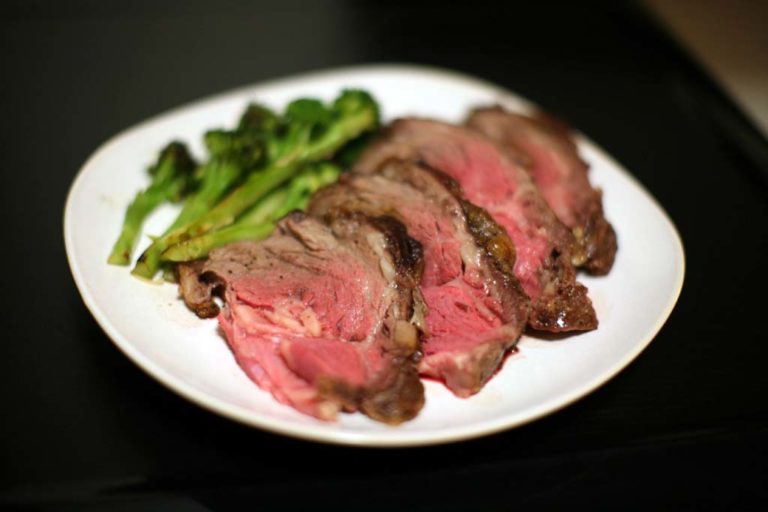
Chef's notes:
Slow roasting is one of the best ways to roast beef. The low temperature of the oven brings up the internal temperature slowly so that the whole roast cooks evenly across its entirety. The result is a piece of meat that is exactly how you like it, from the crust to the center.
The only problem with slow roasting is it’s slow, taking 4–5 hours depending on the size of the roast (buy rib roast here). Slow-cooked roasts are a commitment. But if you are willing to devote the time, you will be rewarded.
The problem with faster roasting procedures is that you only get a small center chunk that is done the way you like it. Not that the surrounding area isn’t delicious, but let’s face it–unless you cooked the center rare, the rest is overcooked.
I recommend you set aside some time and try this recipe. You’re worth the wait.
Ingredients
- 5 pound boneless ribeye roast
- Kosher salt
- Fresh-ground black pepper
- Vegetable oil
Slow-Roasted Beef Standing Rib Roast Recipe: 200 degrees F For about Four Hours with a Bit of Salt and Pepper
- Take the beef out of the fridge a couple of hours before you want to roast it so it warms up to close to room temperature. When you are ready to roast the beef, preheat the oven to 250 degrees F. If your roast has a thick fat layer, score it in a criss-cross pattern. Season the roast with salt and pepper, and rub it in with your hands. Finish the roast off with a coating of vegetable oil, and rub that in as well. The oil will help to caramelize the exterior of the roast in a process know as the Maillard reaction. If you are roasting it in a pan with a rack, make a tray out of aluminum foil to catch the drippings and put it under the roast in the pan.
- Once you have finished prepping the roast and the oven is up to heat, turn the oven down to 200 degrees F and put the roast in. If you have a thermometer that can be in the roast while it is in the oven, put that in the very center of the roast. You will let the roast cook until it reaches 118 degrees F. So knowing what the internal temperature of the roast is as it cooks is mighty handy. For my 5-pound rib roast, it took 4 hours to get to 118. My thermometer has a temperature alarm, so I just sat back and waited for the alarm to go off when it reached the appropriate temp.
- Once the beef roast has reached an internal temp of 118 degrees F, take it out of the oven and crank the oven to 500 degrees F. The roast may not look very appetizing right now, but after this step, it will look very tasty. While the roast is outside of the oven, cover it loosely with aluminum foil to keep it from cooling down. My roast sat out for 20 minutes and only lost 2 degrees because it was covered with foil. The reason you are getting the oven so hot is because the outside of the roast needs to be finished. The high heat will brown and caramelize the fat and make it delicious. While the outside of the roast is getting nice and crispy, the inside of the roast will be finishing as well, which is why you only cooked the middle to 118.
- When the oven is up to 500 degrees, put the beef roast back in uncovered with a thermometer to monitor internal temperature. If you like a rare roast, cook it 125 degrees F. If you like medium, 135 is your number, and for you sadists who like well done, 145 is the magic number. I cooked mine to 128 on the dot because I like it raw and wriggling. Most importantly, once you have taken your roast out of the oven, let it rest for 20 minutes before eating it. Inside the juices are bubbling and hot, and if you cut into it fresh out the oven, you will lose all of those juices. To serve the roast, remove the rib section and slice it to order across the grain. Enjoy. (the ribs are the second best part, don’t waste them!)
Tips & Tricks
- Some people like to cover their roasts while they are in the oven. I prefer a dry heat cooking method for my roasts. Covered vessels create a chamber to trap steam and basically become a steamer. And steam is a wet heat . . . duh. The moisture affects the way the meat cooks and has a way of removing fat and oil making the roast dry. Kind of a contradiction, right? Wet heat makes dry meat. But it does. So that’s why I stay away from it. Unless I’m making a pot roast. But that is something completely different!
- Try not to open the oven while it’s cooking. The lost heat can greatly increase the cooking time, especially when dealing with low-heat situations. If you don’t have a roasting pan with a rack to elevate the meat off the floor of the pan, you can prop the meat up with sliced onions or apples. Once, I even used shelled pecans to keep the roast off the bottom of the pan. Those pecans were really good, too.
